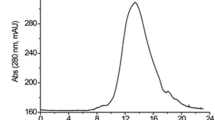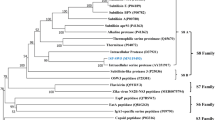Abstract
The screening of proteolytic and fibrinolytic bacteria from moromi (an Indonesian soybean-based fermented food) yielded a number of isolates. Based on morphological and biochemical analyses and sequencing of the 16S rRNA gene, the isolate that exhibited the highest proteolytic and fibrinolytic activity was identified as Bacillus subtilis K2. The study was performed to analyze molecular characteristic of a fibrin-degrading enzyme from B. subtilis K2. BLASTn analysis of the nucleotide sequence encoding this fibrinolytic protein demonstrated 73.6% homology with the gene encoding the fibrin-degrading enzyme nattokinase of the B. subtilis subsp. natto, which was isolated from fermented soybean in Japan. An analysis of the putative amino-acid sequence of this protein indicated that it is a serine protease enzyme with aspartate, histidine, and serine in the catalytic triad. This enzyme was determined to be a 26-kDa molecule, as confirmed with a zymogram assay. Further bioinformatic analysis using Protparam demonstrated that the enzyme has a pI of 6.02, low instability index, high aliphatic index, and low GRAVY value. Molecular docking analysis using HADDOCK indicated that there are favorable interactions between subtilisin K2 and the fibrin substrate, as demonstrated by a high binding affinity (ΔG: − 19.4 kcal/mol) and low Kd value (6.3E-15 M). Overall, the study concluded that subtilisin K2 belong to serine protease enzyme has strong interactions with its fibrin substrate and fibrin can be rapidly degraded by this enzyme, suggesting its application as a treatment for thrombus diseases.





Similar content being viewed by others
References
Wei Q, Wang H, Chen Z (2013) Profiling of dynamic changes in the microbial community during the soy sauce fermentation process. Appl Microbiol Biotechnol 97:9111–9119. https://doi.org/10.1007/s00253-013-5146-9
Chen YJ, Wu KP, Kim S, Falzon L, Inouye M, Baum J (2008) Backbone NMR assignments of DFP-inhibited mature subtilisin E. Biomol NMR Assign 2(2):131–133. https://doi.org/10.1007/s12104-008-9103-y
Sumi H, Hamada H, Tsushima H, Mihara H, Muraki H (1987) A novel fibrinolytic enzyme (nattokinase) in the vegetable cheese natto, a typical and popular soybean food in the Japanese diet. Experentia 43(10):1110–1111. https://doi.org/10.1007/bf01956052
Kim GM, Lee AR, Lee KW, Park JY, Park AY, Chun J, Cha J, Song YS, Kim JH (2009) Characterization of a 27 kDa fibrinolytic enzyme from Bacillus amyloliquefaciens CH51 isolated from cheonggukjang. J Microbiol Biotechnol 19(9):997–1004. https://doi.org/10.4014/jmb.0811.600
Wei X, Luo M, Xu L, Zhang Y, Lin X, Kong P, Liu H (2011) Production of fibrinolytic enzyme from Bacillus amyloliquefaciens by fermentation of chickpeas, with the evaluation of the anticoagulant and antioxidant properties of chickpeas. J Agric Food Chem 59:3957–3963. https://doi.org/10.1021/jf1049535
Jo HD, Lee HA, Jeong S, Kim JH (2011) Purification and characterization of a major fibrinolytic enzyme from Bacillus amyloliquefaciens MJ5-41 isolated from meju. J Microbiol Biotechnol 21(11):1166–1173. https://doi.org/10.4014/jmb.1106.06008
Yoshimoto T, Oyama H, Honda T, Tone H, Takeshita T (1988) Cloning and expression of subtilisin amylosacchariticus gene. J Biochem 103:1060–1065. https://doi.org/10.1093/oxfordjournals.jbchem.a122380
Balaraman K, Prabakaran G (2007) Production and purification of a fibrinolytic enzyme (thrombinase) from Bacillus sphaericus. Indian J Med Res 126:459–464
Kim W, Choi K, Kim Y, Park H, Choi J, Lee Y, Oh H, Kwon I, Lee S (1996) Purification and characterization of a fibrinolytic enzyme produced from Bacillus sp. strain CK 11–4 screened from chungkook-jang. Appl Environ Microbiol 62(7):2482–2488
Fuka MM, Engel M, Haesler F, Welzl G, Munch JC, Schloter M (2008) Diversity of proteolytic community encoding for subtilisin in an arable field: spatial and temporal variability. Biol Fertil Soils 45(2):185–191. https://doi.org/10.1007/s00374-008-0319-x
Głowacka AE, Podstawka E, Szczȩsna-Antczak MH, Kalinowska H, Antczak T (2005) Kinetic and molecular properties of Bacillus subtilis IBTC-3 subtilisin. Comp Biochem Physiol B 140(2):321–331. https://doi.org/10.1016/j.cbpc.2004.10.015
Weng Y, Yao J, Sparks S, Wang KY (2017) Nattokinase: an oral antithrombotic agent for the prevention of cardiovascular disease. Int J Mol Sci 18(3):1–13. https://doi.org/10.3390/ijms18030523
Agrebi R, Haddar A, Hajji M, Frikha F, Manni L, Nasri M (2009) Fibrinolytic enzymes from a newly isolated marine bacterium Bacillus subtilis A26: characterization and statistical media optimization. Can J Microbiol 55:1049–1061. https://doi.org/10.1139/W09-057
Sung JH, Ahn SJ, Kim NY, Jeong SK, Kim JK, Chung JK, Lee HH (2010) Purification, molecular cloning, and biochemical characterization of subtilisin JB1 from a newly isolated Bacillus subtilis JB1. App Biochem Biotechnol 162(3):900–911. https://doi.org/10.1007/s12010-009-8830-6
Syahbanu F, Kezia E, Puera N, Giriwono PE, Tjandrawinata RR, Suhartono MT (2020) Fibrinolytic bacteria of Indonesian fermented soybean: preliminary study on enzyme activity and protein profile. Food Sci Technol. https://doi.org/10.1590/fst.23919
Jeong SJ, Kwon GH, Chun J, Kim JS, Park C, Kwon DAEY, Kim JH (2007) Cloning of fibrinolytic enzyme gene from isolated from and its expression in protease-deficient strains. J Microbiol Biotechnol 17(6):1018–1023
Sambrook J, Fritsch EF, Maniatis T (1989) Molecular cloning a laboratory manual. Cold Spring Harbor, New York
Hwang KJ, Choi KH, Kim MJ, Park CS, Cha J (2007) Purification and characterization of a new fibrinolytic enzyme of Bacillus licheniformis KJ-31, isolated from Korean traditional jeot-gal. J Microbiol Biotechnol 17(9):1469–1476
Bradford MM (1976) A rapid and sensitive method for the quantitation of microgram quantities of protein utilizing the principle of protein-dye binding. Anal Biochem 72:248–254. https://doi.org/10.1006/abio.1976.9999
Schwede T, Kopp J, Guex N, Peitsch MC (2003) SWISS-MODEL: an automated protein homology-modeling server. Nucleic Acids Res 31(13):3381–3385. https://doi.org/10.1093/nar/gkg520
DeLano WL (2002) Pymol: an open-source molecular graphics tool. CCP4 Newslett Protein Crystallogr 40:82–92
Geourjon C, Deléage G (1995) Sopma: significant improvements in protein secondary structure prediction by consensus prediction from multiple alignments. Bioinformatics 11(6):681–684. https://doi.org/10.1093/bioinformatics/11.6.681
Lovell SC, Davis IW, Adrendall WB, de Bakker PIW, Word JM, Prisant MG, Richardson JS, Richardson DC (2003) Structure validation by C alpha geometry : phi, psi, and c beta deviation. Proteins Struct Funct Bioinf 50:437–450. https://doi.org/10.1002/prot.10286
Laskowski RA, MacArthur MW, Moss DS, Thornton JM (1993) PROCHECK: a program to check the stereochemical quality of protein structures. J Appl Crystallogr 26(2):283–291. https://doi.org/10.1107/s0021889892009944
Wiederstein M, Sippl MJ (2007) ProSA-web: interactive web service for the recognition of errors in three-dimensional structures of proteins. Nucleic Acids Res 35(2):407–410. https://doi.org/10.1093/nar/gkm290
Einsenberg D, Luthy R, Bowie J (1997) Verify3D: assessment of protein models with three-dimensional profiles. Methods Enzymol 277:396–404. https://doi.org/10.1016/s0076-6879(97)77022-8
Maiti R, Van Domselaar GH, Zhang H, Wishart DS (2004) SuperPose: a simple server for sophisticated structural superposition. Nucleic Acids Res 32:590–594. https://doi.org/10.1093/nar/gkh477
de Vries SJ, Bonvin AMJJ (2011) CPORT: a consensus interface predictor and its performance in prediction-driven docking with HADDOCK. PLoS ONE. https://doi.org/10.1371/journal.pone.0017695
Van Zundert GCP, Rodrigues JPGLM, Trellet M, Schmitz C, Kastritis PL, Karaca E, Melquiond ASJ, van Dijk M, de Vries SJ, Bonvin AMJJ (2016) The HADDOCK2.2 web server: user-friendly integrative modeling of biomolecular complexes. J Mol Biol 428(4):720–725. https://doi.org/10.1016/j.jmb.2015.09.014
Cukuroglu E, Gursoy A, Keskin O (2012) HotRegion: a database of predicted hot spot clusters. Nucleic Acids Res 40(D1):829–833. https://doi.org/10.1093/nar/gkr929
Xue LC, Rodrigues JP, Kastritis PL, Bonvin AMJJ, Vangone A (2016) PRODIGY: a web server for predicting the binding affinity of protein-protein complexes. Bioinformatics 32(23):3676–3678. https://doi.org/10.1093/bioinformatics/btw514
Wallace AC, Laskowski RA, Thornton JM (1995) LIGPLOT: a program to generate schematic diagrams of protein-ligand interactions. Protein Eng 8(2):127–134. https://doi.org/10.1093/protein/8.2.127
Gholami A, Shahin S, Mohkam M, Nezafat N, Ghasemi Y (2015) Cloning, characterization, and bioinformatics analysis of novel cytosine deaminase from Escherichia coli AGH09. Int J Pept Res Ther 21(3):365–374. https://doi.org/10.1007/s10989-015-9465-9
Chakraborty N, Besra A, Basak J (2020) Molecular cloning of an amino acid permease gene and structural characterization of the protein in common bean (Phaseolus vulgaris L.). Mol Biotechnol 62(3):210–217. https://doi.org/10.1007/s12033-020-00240-4
Kumar S, Tsai C, Nussinov R (2000) Factors enhancing protein thermostability. Protein Eng 13(3):179–191. https://doi.org/10.1093/protein/13.3.179
Santiveri CM, Santoro J, Rico M, Énez MAJIM (2004) Factors involved in the stability of isolated beta sheets : turn sequence, beta sheet twisting, and hydrophobic surface burial. Protein Sci 13:1134–1147. https://doi.org/10.1110/ps.03520704.also
Irajie C, Mohkam M, Nezafat N, Mohammadi F (2017) In silico analysis of nattokinase from Bacillus subtilis sp natto. Int J Pharm Clin Res 9(4):286–292. https://doi.org/10.25258/ijpcr.v9i04.8535
Moreira IS, Koukos PI, Melo R, Almeida JG, Antonio JP, Schaarschmidt J, Trellet M, Gümüş ZH, Costa J, Bonvin AMJJ (2017) SpotOn: high accuracy identification of protein-protein interface hot-spots. Sci Rep 7(1):8007. https://doi.org/10.1038/s41598-017-08321-2
Sarvagalla S, Cheung CHA, Tsai JY, Hsieh HP, Coumar MS (2016) Disruption of protein-protein interactions: hot spot detection, structure-based virtual screening and in vitro testing for the anti-cancer drug target-survivin. RSC Adv 6(38):31947–31959. https://doi.org/10.1039/c5ra22927h
Kastritis PL, Rodrigues JPGLM, Folkers GE, Boelens R, Bonvin AMJJ (2014) Proteins feel more than they see: fine-tuning of binding affinity by properties of the non-interacting surface. J Mol Biol 426(14):2632–2652. https://doi.org/10.1016/j.jmb.2014.04.017
Wu JX, Zhao XY, Pan R, He RQ (2007) Glycosylated trypsin-like proteases from earthworm Eisenia fetida. Int J Biol Macromol 40:399–406. https://doi.org/10.1016/j.ijbiomac.2006.10.001
Yogesh D, Halami PM (2015) Evidence that multiple proteases of Bacillus subtilis can degrade fibrin and fibrinogen. Int Food Res J 22(4):1662–1667
Suwanmanon K, Hsieh PC (2014) Effect of γ-aminobutyric acid and nattokinase-enriched fermented beans on the blood pressure of spontaneously hypertensive and normotensive Wistar-Kyoto rats. J Food Drug Anal 22(4):485–491. https://doi.org/10.1016/j.jfda.2014.03.005
Nailufar F, Tjandrawinata RR, Suhartono MT (2016) Thrombus degradation by fibrinolytic enzyme of Stenotrophomonas sp. originated from Indonesian soybean-based fermented food on Wistar rats. Adv Pharmacol Sci 2016:1–9. https://doi.org/10.1155/2016/4206908
Kurosawa Y, Nirengi S, Homma T, Esaki K, Ohta M, Clark JF, Hamaoka T (2015) A single-dose of oral nattokinase potentiates thrombolysis and anti-coagulation profiles. Sci Rep 5:1–7. https://doi.org/10.1038/srep11601
Dabbagh F, Negahdaripour M, Berenjian A, Behfar A, Mohammadi F, Zamani M, Irajie C, Ghasemi Y (2014) Nattokinase: production and application. Appl Microbiol Biotechnol 98(22):9199–9206. https://doi.org/10.1007/s00253-014-6135-3
Mohanasrinivasan V, Mohanapriya A, Potdar S, Chatterji S, Konne S, Kumari S, Keziah M, Subathra DC (2017) In vitro and in silico studies on fibrinolytic activity of nattokinase: a clot buster from Bacillus sp. Front Biol 12(3):219–225. https://doi.org/10.1007/s11515-017-1453-3
Ferrall-Fairbanks MC, West DM, Douglas SA, Averett RD, Platt MO (2018) Computational predictions of cysteine cathepsin-mediated fibrinogen proteolysis. Protein Sci 27(3):714–724. https://doi.org/10.1002/pro.3366
Zheng Z, Zuo Z, Liu Z, Tsai K (2005) Construction of a 3D model of nattokinase, a novel fibrinolytic enzyme from Bacillus natto a novel nucleophilic catalytic mechanism for nattokinase. J Mol Graph Model 23:373–380. https://doi.org/10.1016/j.jmgm.2004.10.002
Ezat AA, El-Bialy NS, Mostafa HIA, Ibrahim MA (2014) Molecular docking investigation of the binding interactions of macrocyclic inhibitors with HCV NS3 protease and its mutants (R155K, D168A, and A156V). Protein J 33(1):32–47. https://doi.org/10.1007/s10930-013-9538-6
Acknowledgements
This work was supported by Master Program of Education Leading to Doctoral Degree for Excellent Graduates (PMDSU), Ministry of Research, Technology and Higher Education of the Republic of Indonesia (RISTEKDIKTI) [Grant No. 025/E3/2017]. This research was supported By Research Grant for acceleration of PhD graduate (Fathma Syahbanu) from the Ministry of Higher Education 2015–2020 to Bogor Agricultural University (IPB) with Prof. Maggy T Suhartono as the Principle Investigator and Major Advisor.
Funding
The author(s) received financial support for the research and/or publication from Master Program of Education Leading to Doctoral Degree for Excellent Graduates (PMDSU), Ministry of Research, Technology and Higher Education of the Republic of Indonesia (RISTEKDIKTI) [Grant No. 025/E3/2017].
Author information
Authors and Affiliations
Contributions
FS: writing-original draft preparation, editing, methodology, software; PEG: data curation, validation, bioinformatic methodology; RRT: investigation, data curation, editing: MTS: supervision, conceptualization, methodology, validation.
Corresponding author
Ethics declarations
Conflict of interest
The author(s) declared no potential conflicts of interest with respect to the research, authorship, and/or publication of this article.
Ethical approval
The bacteria as source of the gene and enzyme was isolated from local soy fermented food. The data taken for result and discussion were original and came from the experimets stated in the methodology. This research did not involve the type of work that could be a threat to public health, does not produce any biological agents or toxins.
Research involving human and animal participants
This research did not use any animal or human subject. All methodology applied were in accordance with the reference cited.
Additional information
Publisher's Note
Springer Nature remains neutral with regard to jurisdictional claims in published maps and institutional affiliations.
Rights and permissions
About this article
Cite this article
Syahbanu, F., Giriwono, P.E., Tjandrawinata, R.R. et al. Molecular analysis of a fibrin-degrading enzyme from Bacillus subtilis K2 isolated from the Indonesian soybean-based fermented food moromi. Mol Biol Rep 47, 8553–8563 (2020). https://doi.org/10.1007/s11033-020-05898-2
Received:
Accepted:
Published:
Issue Date:
DOI: https://doi.org/10.1007/s11033-020-05898-2




